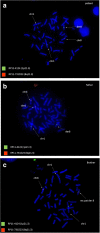A familial chromosomal complex rearrangement confirms RUNX1T1 as a causative gene for intellectual disability and suggests that 1p22.1p21.3 duplication is likely benign
- PMID: 31223340
- PMCID: PMC6570965
- DOI: 10.1186/s13039-019-0440-6
A familial chromosomal complex rearrangement confirms RUNX1T1 as a causative gene for intellectual disability and suggests that 1p22.1p21.3 duplication is likely benign
Abstract
Background: Complex chromosomal rearrangements are constitutive structural aberrations involving three or more breaks. They can be balanced or unbalanced and result in different outcomes, depending on deletion/duplication of genomic material, gene disruption, or position effects.
Case presentation: We report on a patient presenting with severe anemia, splenomegaly, mild intellectual disability and facial dysmorphisms harboring a 4.3 Mb duplication at 1p22.1p21.3 and a 2.1 Mb deletion at 8q21.3q22.1, involving RUNX1T1 gene. The healthy brother presented the same duplication of chromosome 1p as at 1p22.1p21.3.
Conclusions: The rearrangement found both these siblings resulted from malsegregation in the proband and recombination in her healthy brother of a balanced paternal complex chromosomal rearrangement. These results confirm RUNX1T1 as a causative gene for intellectual disability and suggest the 1p22.1p21.3 duplication is likely benign.
Keywords: 1p22.1p21.3 duplication; 8q21.3q22.1 deletion; Complex chromosomal rearrangements; RUNX1T1.
Conflict of interest statement
Competing interestsThe authors declare that they have no competing interests.
Figures
Similar articles
-
Rare 15q21.1q22.31 Duplication Due to a Familial Chromosomal Insertion and Diagnostic Investigation in a Carrier of Balanced Chromosomal Rearrangement and Intellectual Disability.Genes (Basel). 2023 Apr 9;14(4):885. doi: 10.3390/genes14040885. Genes (Basel). 2023. PMID: 37107643 Free PMC article.
-
Interstitial 10q21.1q23.31 Duplication due to Meiotic Recombination of a Paternal Balanced Complex Rearrangement: Cytogenetic and Molecular Characterization.Cytogenet Genome Res. 2017;151(4):179-185. doi: 10.1159/000475490. Epub 2017 May 6. Cytogenet Genome Res. 2017. PMID: 28478456
-
An Apparently Balanced Complex Chromosome Rearrangement Involving Seven Breaks and Four Chromosomes in a Healthy Female and Segregation/Recombination in Her Affected Son.Mol Syndromol. 2021 Aug;12(5):312-320. doi: 10.1159/000516323. Epub 2021 Jul 15. Mol Syndromol. 2021. PMID: 34602959 Free PMC article.
-
Association of new deletion/duplication region at chromosome 1p21 with intellectual disability, severe speech deficit and autism spectrum disorder-like behavior: an all-in approach to solving the DPYD enigma.Transl Neurosci. 2015 Mar 2;6(1):59-86. doi: 10.1515/tnsci-2015-0007. eCollection 2015. Transl Neurosci. 2015. PMID: 28123791 Free PMC article. Review.
-
Characterization of a familial balanced rec(13) in a child with mild MR and his half-sibling with two structurally rearranged chromosomes 13.Am J Med Genet A. 2005 Aug 30;137(2):217-21. doi: 10.1002/ajmg.a.30866. Am J Med Genet A. 2005. PMID: 16059944 Review.
Cited by
-
Germline de novo alterations of RUNX1T1 in individuals with neurodevelopmental and congenital anomalies.HGG Adv. 2025 Jan 9;6(1):100384. doi: 10.1016/j.xhgg.2024.100384. Epub 2024 Nov 20. HGG Adv. 2025. PMID: 39568205 Free PMC article.
References
-
- Gardner RJM, Sutherland GR, Lisa G. Shaffer, chromosome abnormalities and genetic counselling. UK: Oxford University Press; 2012.
-
- Alesi V, Orlando V, Genovese S, Loddo S, Pisaneschi E, Pompili D, Surace C, Restaldi F, Digilio MC, Dallapiccola B, Dentici ML, Novelli A. Interstitial 10q21.1q23.31 Duplication due to Meiotic Recombination of a Paternal Balanced Complex Rearrangement: Cytogenetic and Molecular Characterization. Cytogenet Genome Res. 2017;151(4):179–185. doi: 10.1159/000475490. - DOI - PubMed
Publication types
LinkOut - more resources
Full Text Sources
Miscellaneous




